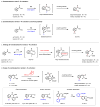Enantioselective remote meta-C-H arylation and alkylation via a chiral transient mediator
- PMID: 29915312
- PMCID: PMC6026055
- DOI: 10.1038/s41586-018-0220-1
Enantioselective remote meta-C-H arylation and alkylation via a chiral transient mediator
Abstract
Enantioselective carbon-hydrogen (C-H) activation reactions by asymmetric metallation could provide new routes for the construction of chiral molecules1,2. However, current methods are typically limited to the formation of five- or six-membered metallacycles, thereby preventing the asymmetric functionalization of C-H bonds at positions remote to existing functional groups. Here we report enantioselective remote C-H activation using a catalytic amount of a chiral norbornene as a transient mediator, which relays initial ortho-C-H activation to the meta position. This was used in the enantioselective meta-C-H arylation of benzylamines, as well as the arylation and alkylation of homobenzylamines. The enantioselectivities obtained using the chiral transient mediator are comparable across different classes of substrates containing either neutral σ-donor or anionic coordinating groups. This relay strategy could provide an alternative means to remote chiral induction, one of the most challenging problems in asymmetric catalysis3,4.
Conflict of interest statement
The authors declare no competing financial interests.
Figures




References
-
- Giri R, Shi BF, Engle KM, Maugel N, Yu JQ. Transition metal-catalyzed C–H activation reactions: diastereoselectivity and enantioselectivity. Chem Soc Rev. 2009;38:3242–3272. - PubMed
-
- Newton CG, Wang SG, Oliveira CC, Cramer N. Catalytic enantioselective transformations involving C–H bond cleavage by transition-metal complexes. Chem Rev. 2017;117:8908–8976. - PubMed
-
- Kakiuchi F, Gendre PL, Yamada A, Ohtaki H, Murai S. Atropselective alkylation of biaryl compounds by means of transition metal-catalyzed C–H/olefin coupling. Tetrahedron: Asymmetry. 2000;11:2647–2651.
-
- Shi BF, Maugel N, Zhang YH, Yu JQ. PdII-catalyzed enantioselective activation of C(sp2)–H and C(sp3)–H bonds using monoprotected amino acids as chiral ligands. Angew Chem Int Ed. 2008;47:4882–4886. - PubMed
Publication types
MeSH terms
Substances
Grants and funding
LinkOut - more resources
Full Text Sources
Other Literature Sources

